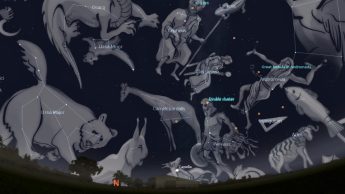This Week’s Sky at a Glance, 2024 August 17 – August 24
This Week’s Sky at a Glance, 2024 August 17 – August 24
The signs of autumn appear in the sky before they become readily apparent terrestrially. In late evening the great mama bear, Ursa Major, scampers across the northern horizon in search of food and lodging for winter. If you live in a rural area with an excellent view to the north you might even catch a glimpse of Lynx running ahead of the bear, and consider yourself fortunate if you do. The thicker layer of atmosphere at low altitudes reduces the brightness of starlight, a phenomenon called extinction. The lynx may become extinct for a few hours.
The bowl of the Little Dipper (Ursa Minor) is upside down in early evening, pouring out its contents to fill the Big Dipper below, at the rear of Ursa Major. This scenario is at odds with Greek mythology, for the bears were cursed to eternal thirst by the goddess Hera in revenge for an indiscretion of her husband, Zeus. She placed the bears in a position where they never reach the horizon for a drink. Perhaps Zeus placed dippers of water inside the bears so that they could share water and survive. Someone has to make these stories up.
To the east Pegasus is already quite high after twilight, with its signature square asterism tilted as a diamond for the imminent baseball pennant stretch. Perseus stands above the northeast horizon below his in-laws, W-shaped Cassiopeia and house-shaped Cepheus, while their daughter Andromeda leads him toward the flying horse. There is much to see in this area with binoculars but start with the Double Cluster of stars between Perseus and Cassiopeia, and the Andromeda Galaxy (M31).
This Week in the Solar System
Saturday’s sunrise in Moncton is at 6:21 and sunset will occur at 8:23, giving 14 hours, 2 minutes of daylight (6:28 and 8:27 in Saint John). Next Saturday the Sun will rise at 6:30 and set at 8:11, giving 13 hours, 41 minutes of daylight (6:36 and 8:15 in Saint John).
The Moon is full on Monday and it rises with Saturn to its left on Tuesday. Mars and Jupiter rise together around 1 am this weekend. Mars slowly pulls away eastward over the week but the pair remain within the same binocular view. Venus sets about 50 minutes after sunset; find it with binoculars first and then try it naked eye. Mercury is at inferior conjunction on Monday, beginning a favourable apparition for morning observing toward the end of the month.
There will be public observing at the Irving Nature Park in Saint John next Friday, August 23, from 8:30 to 11:30 pm (back-up date on August 24).

